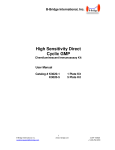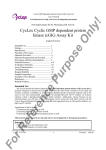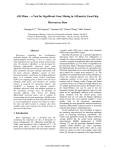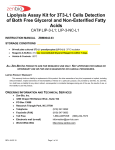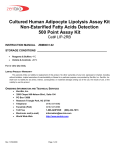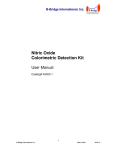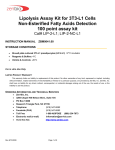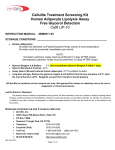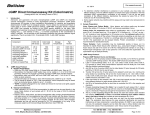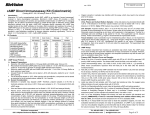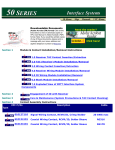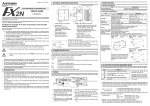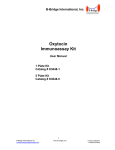Download Direct Cyclic GMP - B-Bridge International, Inc.
Transcript
B-Bridge International, Inc. Direct Cyclic GMP Enzyme Immunoassay Kit User Manual Catalog # K3020-C K3020-C5 1 Plate Kit 5 Plate Kit 1 B-Bridge International, Inc. [email protected] www.b-bridge.com cGMP 150625 +1-408-252-6200 TABLE OF CONTENTS Intended Use 3 Background 3 Assay Principle 3 Kit Components 4 Materials Required 4 Interferents 4 Precautions 5 Sample Preparation 5 Regular Format Assay Protocol 7 Reagent Preparation 7 Assay Protocol 7 Calculations 8 Typical Standard Curve 8 Validation Data 9 Acetylated Assay Protocol 10 Reagent Preparation 10 Acetylation 11 Assay Protocol 11 Calculations 11 Typical Standard Curve 12 Validation Data 12 Notice to Purchaser This product is to be used for Research Purposes Only. It is not to be used for Drug or Diagnostic Purposes, nor is it intended for Human Use. B-Bridge products may not be resold, modified for resale, or used to manufacture commercial products without the express written consent of B-Bridge International, Inc. EXCEPT AS OTHERWISE EXPRESSLY SET FORTH IN THIS USER MANUAL, B-BRIDGE DOES NOT MAKE ANY REPRESENTATION OR WARRANTIES OR CONDITIONS OF ANY KIND, EITHER EXPRESSED OR IMPLIED, WITH RESPECT TO THE PRODUCTS, OR INFORMATION DISCLOSED HEREUNDER, INCLUDING, BUT NOT LIMITED TO, THE IMPLIED WARRANTIES OF MERCHANTABILITY, FIT FOR A PARTICULAR PURPOSE, OR NONINFRINGEMENT OF THE INTELLECTUAL PROPERTY RIGHTS OF THIRD PARTIES. B-Bridge International, Inc. All Rights Reserved. 2 B-Bridge International, Inc. [email protected] www.b-bridge.com cGMP 150625 +1-408-252-6200 INTENDED USE The B-Bridge Direct Cyclic GMP Enzyme Immunoassay Kit is species independent designed to quantitatively measure cGMP present in lysed cells, EDTA plasma, urine, saliva and tissue culture media samples. Please read the complete kit insert before performing this assay. BACKGROUND Guanosine 3’, 5’-cyclic monophosphate (cyclic GMP; cGMP) is a critical and multifunctional second messenger present at levels typically 10-100 fold lower than cAMP in most tissues. Intracellular cGMP is formed by the action of the enzyme guanylate cyclase on GTP and degraded through phosphodiesterase hydrolysis. Guanylate cyclases (GC) are either soluble or membrane bound. Soluble GCs are nitric oxide responsive, whereas membrane bound GCs respond to hormones such as acetylcholine, insulin and oxytocin. Other chemicals like serotonin and histamine also cause an increase in cGMP levels. Cyclic GMP regulates cellular composition through cGMP-dependent kinase, cGMP-dependent ion channels or transporters, and through its hydrolytic degradation by phosphodiesterase. ASSAY PRINCIPLE The B-Bridge Direct Cyclic GMP Enzyme Immunoassay Kit is designed quantitatively measure cGMP present in lysed cells, EDTA plasma, urine, saliva and tissue culture media samples. Please read the complete kit insert before performing this assay. For samples where the levels of cGMP are expected to be relatively high, the regular format for the assay can be used. For samples with expected low levels of cGMP, an optional acetylation protocol can be used. The kit is unique in that all samples and standards are diluted into an acidic Sample Diluent, which contains special additives and stabilizers, for cGMP measurement. This allows plasma, urine and saliva samples to be read in an identical manner to lysed cells. Acidified samples of cGMP are stable and endogenous phosphodiesterases are inactivated in the Sample Diluent. 1. Plate primer added to microtiter plate wells followed by sample or standard. 2. The reaction is initiated with the addition of the cGMP-peroxidase conjugate then the binding reaction is initiated by the addition of a mouse monoclonal antibody to cGMP to each well. 3. After a 2 hour incubation, the plate is washed and substrate is added 4. After a short incubation, the reaction is stopped and the intensity of the generated color is detected in a microtiter plate reader capable of measuring 450 nm wave length. 3 B-Bridge International, Inc. [email protected] www.b-bridge.com cGMP 150625 +1-408-252-6200 KIT COMPONENTS Component: K3020-C K3020-C5 Coated Clear 96-well plate 1 plate 5 plates Cyclic GMP Standard (640 pmol/mL) 70 μl 350 μl Cyclic GMP Antibody 3 ml 13 ml Cyclic GMP Conjugate Concentrate 3 ml 13 ml Sample Diluent Concentrate WARNING: Caustic 12 ml 60 ml Plate Primer 25 ml 25 ml Acetic Anhydride WARNING: Corrosive Lachrymator 2 ml 2 ml Triethylamine WARNING: Corrosive Lachrymator 4 ml 4 ml 20X Wash Buffer Concentrate 30 ml 125 ml TMB Substrate 11 ml 55 ml Stop Solution 5 ml 25 ml Plate Sealer Cat # 1 each Store all components at 4°C 5 each MATERIALS REQUIRED BUT NOT SUPPLIED - Deionized or distilled water - Microplate Shaker - Glass test tubes - 96-well plate reader capable of reading optical density at 450 nm. - Software for converting raw optical density readings from the plate reader and carrying out four parameter logistic curve (4PLC) fitting. INTERFERENTS A variety of detergents were tested as possible interfering substances in the assay. CHAPS, and Tween 20 at 0.1% increased measured cAMP by 8.9 and decreased measured cAMP by 0.9% respectively. Triton X-100 at 2% increased measured cAMP by 1.8% and CTAC at 0.05% increased measured cAMP by 6.3%. Samples containing SDS above 0.01% should not be used in the assay. 4 B-Bridge International, Inc. [email protected] www.b-bridge.com cGMP 150625 +1-408-252-6200 PRECAUTIONS This kit should only be used by qualified personnel who have had laboratory safety instruction. The complete User Manual should be read and understood before using this product. This kit utilizes a peroxidase-based readout system. Buffers, including other manufacturers Wash Buffers, containing sodium azide will inhibit color production from the enzyme. Make sure all buffers used for samples are azide free. Ensure that any plate washing system is rinsed well with deionized water prior to using the supplied Wash Buffer. The supplied Sample Diluent and Sample Diluent Concentrate are acidic The Stop Solution is 1M HCl. These solutions should not come in contact with skin or eyes. Take appropriate precautions when handling these reagents. Caution - corrosive, flammable, and harmful vapor. Use in hood with proper ventilation and wear appropriate protective safety wear. In all cases, please consult your institution’s safety procedures for working with hazardous chemicals. SAMPLE PREPARATION Samples can be used within 2 hours or preparation or stored long-term at -70°C. 24-Hour urine samples may need to have 1 mL concentrated hydrochloric acid added for every 100 mL volume to act as a preservative. Samples containing visible particulate should be centrifuged prior to using. After dilution in the Sample Diluent there may be some precipitation of proteins and the supernatant from the centrifuged samples used. After being diluted in Sample Diluent the samples can be assayed directly within 2 hours, or frozen at ≤ -70°C for later analysis. Severely hemolyzed samples should not be used in this kit. For samples containing low levels of cGMP, the acetylated assay protocol must be used due to its enhanced sensitivity. All standards and samples should be diluted in glass test tubes. Cells Cell lysis buffers containing high concentrations of SDS or other detergents may not be compatible with this assay or may require extra dilution. Please read Interferents section above for more information. This kit is compatible with either adherent or non-adherent cells. The cells can be grown in any suitable sterile containers such as Petri dishes, 12-, 48- or 96-well culture plates or flasks. The cells must be isolated from the media prior to being lysed with the provided Sample Diluent. The acidic Sample Diluent contains detergents to lyse the cells, inactivate endogenous phosphodiesterases and stabilize the cGMP. Some cell types are extremely hardy and the end user should optimize the lysis conditions utilizing freeze-thaw cycles and ultrasonic treatments to fully lyse their cells. For adherent cells, the media should be aspirated from the cells and the cells washed with PBS. The adherent cells should be treated directly with the Sample Diluent for 10 minutes at room temperature. Cells can be scraped to dislodge them from the plate surface and cells should be inspected to ensure lysis. Detergent has been added to the Sample Diluent to help lysis occur. Centrifuge the samples at ≥600 x g at 4°C for 15 minutes and assay the supernatant directly. If required, the TCM can be assayed for cGMP as outlined below. For non-adherent cells, pellet and wash the cells with PBS by centrifuging the samples at ≥600 x g at 4°C for 15 minutes as described above. Treat the aspirated, washed pellet directly with the Sample Diluent for 10 minutes at room temperature. Cells should be inspected to ensure lysis. Detergent has been added to the Sample Diluent to help lysis occur. Centrifuge the samples at ≥600 x g at 4 °C for 15 minutes and assay the supernatant directly. If required, the TCM can be assayed for cGMP as outlined below. Tissue Samples Tissues samples should be frozen in liquid nitrogen and stored at -80°C if analysis is not to be carried out immediately. Grind the frozen tissue in a stainless steel mortar under liquid nitrogen until it is a fine powder. Allow the liquid nitrogen to evaporate and weigh the powdered tissue. Add 1 mL of Sample Diluent for every 100 mg of tissue. Incubate in the Sample Diluent for 10 minutes on ice, and then centrifuge at ≥600 x g at 4°C for 15 minutes. Collect the supernatant and run in the assay immediately or store frozen at ≤ -70°C. 5 B-Bridge International, Inc. [email protected] www.b-bridge.com cGMP 150625 +1-408-252-6200 For samples that require concentration and delipidation, a trichloroacetic acid (TCA)/ether protocol can be used. Grind the frozen tissue in a stainless steel mortar under liquid nitrogen until it is a fine powder. Allow the liquid nitrogen to evaporate and weigh the powdered tissue. Add 1 mL of ice cold 5% TCA (weight/volume) for every 100 mg of tissue and grind in a glass-Teflon mortar. Incubate in the TCA for 10 minutes on ice, and then centrifuge at ≥600 x g at 4°C for 15 minutes. Collect the supernatant. For every 1 mL of TCA supernatant add 3 mL of water saturated diethyl ether* and shake in a glass vial. Allow the ether to separate as the top layer, remove it and discard the ether. Dry the aqueous layer by lyophilization or using a vacuum centrifuge. Reconstitute by adding 1 mL of Sample Diluent for every mL of 5% TCA used to extract and run in the assay immediately or store at ≤ -70°C. Diethyl ether is extremely flammable and should be used in a hood. Tissue Culture Media For measuring cGMP in tissue culture media (TCM), samples should be read off a standard curve generated in TCM. Samples may need to be diluted further in TCM. We have validated the assay using RPMI-1640. Plasma Samples Plasma samples should be diluted ≥ 1:10 with the supplied Sample Diluent and acetylated prior to running in the Acetylated Format assay. Urine Samples Urine samples should be diluted ≥ 1:5 with the supplied Sample Diluent prior running in the assay. Due to the high concentration of cGMP in urine, samples may need to be diluted further. Saliva Samples Saliva samples should be diluted ≥ 1:4 with the supplied Sample Diluent prior running in the assay. Use all samples within 2 hours of dilution in Sample Diluent. 6 B-Bridge International, Inc. [email protected] www.b-bridge.com cGMP 150625 +1-408-252-6200 REGULAR FORMAT ASSAY REGULAR FORMAT REAGENT PREPARATION Allow the kit reagents to come to room temperature for 30-60 minutes. We recommend that all standards and samples be run in duplicate to allow the end user to accurately determine cAMP concentrations. Ensure that all samples have reached room temperature and have been diluted as appropriate prior to running them in the kit. Wash Buffer Dilute Wash Buffer Concentrate 1:20 by adding one part of the concentrate to nineteen parts of deionized water. Once diluted this is stable at room temperature for 3 months. Standard Preparation All standards and samples should be diluted in glass test tubes. 1. Label seven test tubes as #1 through #7. 2. Pipet 380 μL of Sample Diluent into tube #1 and 200 μL into tubes #2 to #7. 3. The Cyclic GMP stock solution contains an organic solvent. Prerinse the pipet tip several times to ensure accurate delivery. Carefully add 20 μL of the cGMP stock solution to tube #1 and vortex completely. 4. Take 200 µL of the cGMP solution in tube #1 and add it to tube #2 and vortex completely. 5. Repeat the serial dilutions for tubes #3 through #7. The concentration of Cyclic GMP in tubes 1 through 7 will be 32, 16, 8, 4, 2, 1, and 0.5 pmol/mL. Use Standards within 1 hour of preparation. Reagent Sample Diluent cGMP Standard Stock Solution Standard 1 Standard 2 Standard 3 Standard 4 Standard 5 Standard 6 Final Concentration (pM/ml) Standard 1 380 µl Standard 2 200 µl Standard 3 200 µl Standard 4 200 µl Standard 5 200 µl Standard 6 200 µl Standard 7 200 µl 20 µl - - - - - - - 200 µl 32 16 200 µl 200 µl 200 µl 200 µl 200 µl 8 4 2 1 0.5 REGULAR FORMAT ASSAY PROTOCOL 1. Add 50 μL of Plate Primer into all wells used. Failure To Add Plate Primer To ALL Wells First Will Cause Assay To Fail. 2. Pipet 75 μL Sample Diluent into the non-specific binding (NSB) wells. 3. Pipet 50 μL of Sample Diluent into wells to act as maximum binding wells (B0 or 0 pg/mL). 4. Pipet 50 μL of samples or standards into wells in the plate. NOTE: Sample Diluent will turn from orange to bright pink upon sample or standard addition to the Plate Primer in the wells. 7 B-Bridge International, Inc. [email protected] www.b-bridge.com cGMP 150625 +1-408-252-6200 5. Add 25 μL of the diluted cGMP Conjugate to each well using a repeater or multichannel pipet. 6. Add 25 μL of the cGMP Antibody to each well, except the NSB wells, using a repeater or multichannel pipet. 7. Cover the plate with the plate sealer and shake the plate for 2 hours at room temperature. 8. Aspirate the plate and wash each well 4 times with 300 µL wash buffer. Tap the plate dry on clean absorbent towels.. 9. Add 100 µL of the TMB Substrate to each well, using a repeater or multichannel pipet. 10. Incubate the plate at room temperature for 30 minutes without shaking. 11. Add 50 µL of the Stop Solution to each well, using a repeater or multichannel pipet. 12. Read the optical density generated from each well in a plate reader capable of reading at 450 nm. 13. Use the plate reader’s built-in 4PLC software capabilities to calculate cGMP concentration for each sample. CALCULATIONS Average the duplicate OD readings for each standard and sample. Create a standard curve by reducing the data using the 4PLC fitting routine on the plate reader, after subtracting the mean OD’s for the NSB. The sample concentrations obtained, calculated from the %B/B0 curve, should be multiplied by the dilution factor to obtain neat sample values. REGULAR FORMAT TYPICAL STANDARD CURVE: EXAMPLE 8 B-Bridge International, Inc. [email protected] www.b-bridge.com cGMP 150625 +1-408-252-6200 VALIDATION DATA: REGULAR FORMAT Sensitivity and Limit of Detection Sensitivity was calculated by comparing the OD’s for twenty wells run for each of the B0 and standard #7. The sensitivity was determined at two (2) standard deviations from the B0 along the standard curve. Sensitivity was determined as 0.28 pmol/mL. The Limit of Detection for the assay was determined in a similar manner by comparing the OD’s for twenty runs for each of the zero standard and a low concentration human urine sample. Limit of Detection was determined as 0.26 pmol/mL 9 B-Bridge International, Inc. [email protected] www.b-bridge.com cGMP 150625 +1-408-252-6200 ACETYLATED ASSAY Use this format for any sample with low cGMP concentrations. Prior to running the acetylated assay, all standards, samples and the Sample Diluent used for the B0 and NSB wells must be acetylated. Acetylation is carried out by adding 10 μL of the Acetylation Reagent (as prepared below) for each 200 μL of the standard, sample and Sample Diluent. Immediately vortex each treated standard, sample or Sample Diluent after addition of the Acetylation Reagent and use within 30 minutes of preparation. Note: Upon Acetylation, all of the standards and samples diluted in the orange Sample Diluent will change to a pale yellow colour. ACETYLATED ASSAY REAGENT PREPARATION We recommend that all standards and samples be run in duplicate to allow the end user to accurately determine cAMP concentrations. Ensure that all samples have reached room temperature and have been diluted as appropriate prior to running them in the kit. Wash Buffer Dilute Wash Buffer Concentrate 1:20 by adding one part of the concentrate to nineteen parts of deionized water. Once diluted this is stable at room temperature for 3 months. Reagent Acetic Anhydride Volume (uL) Triethylamine Volume (uL) Acetylation Reagent Volume (mL) Number of Samples to be Tested 40 20 100 200 200 400 1,000 2,000 400 800 2,000 4,000 1.2 0.6 3 6 Standard Preparation All standards and samples should be diluted in glass test tubes. 1. Label seven test tubes as #1 through #7 2. Pipet 620 µL of Sample Diluent into tube #1 and 300 µL into tubes #2 to #7. 3. The Cyclic GMP stock solution contains an organic solvent. Prerinse the pipet tip several times to ensure accurate delivery 4. Carefully add 20 µL of the cGMP stock solution to tube #1 and vortex completely. 5. Take 300 µL of the cGMP solution in tube #1 and add it to tube #2 and vortex completely. 6. Repeat the serial dilutions for tubes #3 through #7. The concentration of Cyclic GMP in tubes 1 through 7 will be 20, 10, 5, 2.5, 1.25, 0.625, and 0.3125 pmol/mL. Use Standards within 1 hour of preparation. Reagent Sample Diluent cGMP Standard Stock Solution Standard 1 Standard 2 Standard 3 Standard 4 Standard 5 Standard 6 Final Concentration (pM/ml) Standard 1 620 µl Standard 2 300 µl Standard 3 300 µl Standard 4 300 µl Standard 5 300 µl Standard 6 300 µl Standard 7 300 µl 20 - - - - - - - 300 µl - 300 µl - 300 µl - 300 µl - 300 µl - 300 µl 20 10 5 2.5 1.25 0.625 0.313 10 B-Bridge International, Inc. [email protected] www.b-bridge.com cGMP 150625 +1-408-252-6200 STANDARD AND SAMPLE ACETYLATION 1. Pipet 300 μL of Sample Diluent into a glass tube to act as the Zero standard/NSB tube. 2. Add 15 μL of Acetylation Reagent to this tube and vortex immediately. Proceed to assay within 30 minutes. 3. Pipet 200 μL of each standard and sample to be tested into glass tubes. 4. Add 10 μL of the Acetylation Reagent into each tube and vortex immediately. Proceed to assay within 30 minutes. NOTE: Samples and Sample Diluent will turn from orange to pale yellow upon acetylation. ACETYLATED ASSSAY PROTOCOL 1. Add 50 μL of Plate Primer into all wells used. Failure To Add Plate Primer To ALL Wells First Will Cause Assay To Fail. 2. Pipet 75 μL acetylated Sample Diluent into the non-specific binding (NSB) wells. 3. Pipet 50 μL of acetylated Sample Diluent into wells to act as maximum binding wells (B0 or 0 pg/mL). 4. Pipet 50 μL of acetylated samples or standards into wells in the plate. 5. Add 25 μL of the diluted cGMP Conjugate to each well using a repeater or multichannel pipet. 6. Add 25 μL of the cGMP Antibody to each well, except the NSB wells, using a repeater or multichannel pipet. 7. Gently tap the sides of the plate to ensure adequate mixing of the reagents. Cover the plate with the plate sealer and shake at room temperature for 2 hours. If the plate is not shaken, signals bound will be approximately 25% lower. Note: Wells will have turned from very pale yellow to pale pink during incubation. 8. Aspirate the plate and wash each well 4 times with 300 µL wash buffer. Tap the plate dry on clean absorbent towels. 8. Add 100 µL of the TMB Substrate to each well, using a repeater pipet. 9. Incubate the plate at room temperature for 30 minutes without shaking. 10. Add 50 µL of the Stop Solution to each well, using a repeater pipet. 11. Read the optical density generated from each well in a plate reader capable of reading at 450 nm. 12. Use the plate reader’s built-in 4PLC software capabilities to calculate cGMP concentration for each sample. CALCULATIONS Average the duplicate OD readings for each standard and sample. Create a standard curve by reducing the data using the 4PLC fitting routine on the plate reader, after subtracting the mean OD’s for the NSB. The sample concentrations obtained, calculated from the %B/B0 curve, should be multiplied by the dilution factor to obtain neat sample values. 11 B-Bridge International, Inc. [email protected] www.b-bridge.com cGMP 150625 +1-408-252-6200 ACETYLATED FORMAT TYPICAL STANDARD CURVE: EXAMPLE VALIDATION DATA: ACETYLATED FORMAT Sensitivity and Limit of Detection - Acetylated Sensitivity was calculated by comparing the OD’s for twenty wells run for each of the acetylated B0 and standard #7. The sensitivity was determined at two (2) standard deviations from the B0 along the standard curve. Sensitivity was determined as 0.188 pmol/mL. The Limit of Detection for the assay was determined in a similar manner by comparing the OD’s for twenty runs for each of acetylated zero standard and a low concentration acetylated human sample. Limit of Detection was determined as 0.210 pmol/mL 12 B-Bridge International, Inc. [email protected] www.b-bridge.com cGMP 150625 +1-408-252-6200












